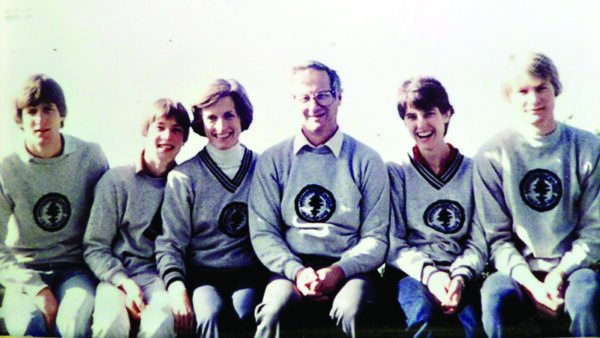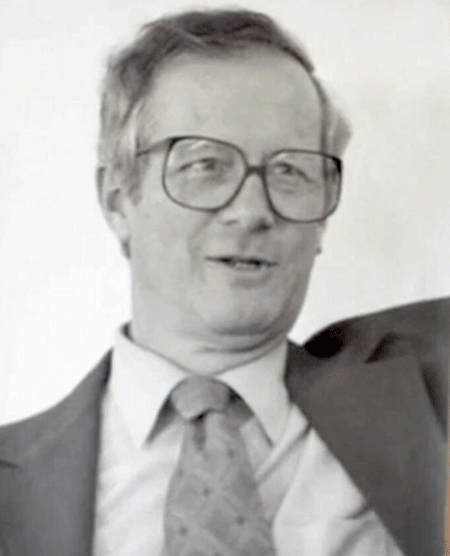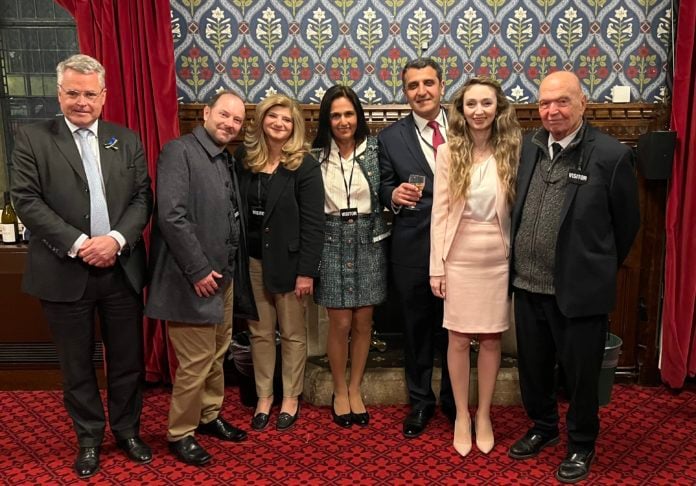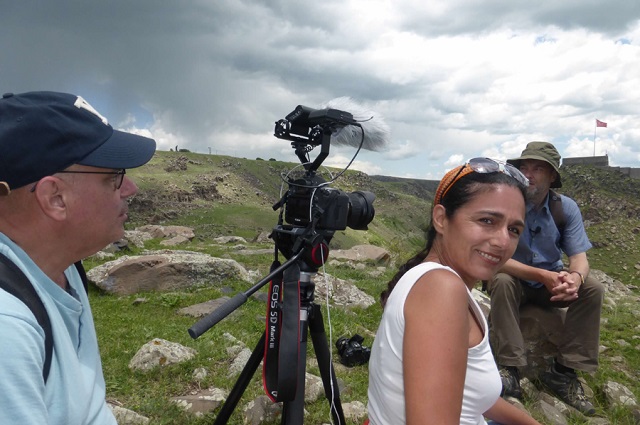by The Armenian Mirror-Spectator
LOS ANGELES — On Wednesday, April 12, the Promise Armenian Institute at UCLA introduced a newly endowed lecture series named in honor of the Kerr family. With the backing of Promise Institute benefactor Eric Esrailian and the participation of the Kerrs, who have been involved with humanitarian work and education (notably among the Armenian community and in the Middle East) for three generations, the lecture series has “the aim of amplifying the stories of heroes and heroines who dedicated themselves to providing humanitarian support for victims and survivors of violence and mass atrocities in times of crisis.”
The first lecture in the series was dedicated to the Kerr family itself, about whom filmmaker Ani Hovannisian is making a documentary. The lecture, titled “The Extraordinary Humanitarian Legacy of the Near East Relief and Three Generations of Kerrs, Warriors of Peace,” was an overview of the research Hovannisian has already done on the documentary and rough film clips she has put together so far.

Malcolm and Ann Kerr with their four children (Steve Kerr at far right)
The Kerr family’s ties to the Middle East goes back two generations. Stanley and Elsa Kerr were American humanitarian relief workers who travelled to the former Ottoman Empire at the end of World War I as part of the US-based Near East Relief organization, which saved thousands of refugees and orphans of the Armenian Genocide. They met and married during their service there. Afterward, they remained in the region as faculty at the American University of Beirut, where most of their children were born, and where son Malcolm in particular followed in their footsteps as a professor at the same institution, eventually becoming its president.
Read also
Malcolm, who was assassinated in 1984 by members of an Iranian-backed militant group during the Lebanese Civil War, gave his life to improving the education and quality of life of the people of the Middle East, as did his parents. His wife, Ann, continues his mission of education and building cultural bridges in her career as a professor at UCLA. The rest of the children, grandchildren and now great-grandchildren of Stanley and Elsa Kerr, also carry on the legacy of human rights and helping others while achieving great success. One of the sons of Malcolm and Ann, Steve Kerr, head coach of the NBA’s Golden State Warriors, has been outspoken about his pride in his family’s role providing relief to Armenian Genocide survivors.
Inaugural Lecture Dedicated to Kerr Family
After welcoming remarks by Promise Institute director Prof. Ann Karagozian, UCLA’s Prof. Emeritus Richard Hovannisian delivered an introduction giving context to the main presentation, which would be given by his daughter, Ani.
The introduction gave the background of the US involvement in relief efforts, by outlining the history of American missionary presence in the Ottoman Empire. The American Board of Commissioners for Foreign Missions (ABCFM), an umbrella group mostly backed by New England Congregationalists, had been sending missionaries to Turkey for nearly a century, setting up a vast network of schools, colleges, hospitals, churches, and mission stations throughout the country. Most of the students in their schools in Anatolia were Armenians, with smaller numbers of Greeks and Bulgarians. They viewed themselves as not only bringing the Christian religion to underdeveloped countries, but as bringing enlightenment and education to such areas, and their educational work among Ottoman Armenians was extremely influential. As Hovannisian described it, Americans were everywhere in Turkey and when the Genocide happened, many of them heroically stood by their students when the deportations started in 1915.

Near East Relief workers in Marash, 1920. Stanley Kerr is third from the right.
Notably, the largest missionary presence was in the Kharpert region, which is likely why more Armenian immigrants in the US prior to World War II hailed from that region rather than from any other part of the world.
With this background, when the war ended, the US government chartered the non-sectarian Near East Relief organization which coordinated almost all the previous missionary institutions along with new volunteers arriving from the US into one unified front, for the purpose of overseeing refugee camps, orphanages, and newly established schools mostly in places like Syria and Lebanon where the Genocide survivors had arrived. Near East Relief workers also went to the cities of Cilicia, where there was an attempt to allow Armenians to return to live in the region (even if they were not originally from there) under French military protection. Stanley Kerr was first stationed in Aleppo, Syria, and then assigned to Marash, Cilicia, until the Kemalists forced all remaining or returnee Armenians to leave in 1922.
Documentary in the Works
Ani Hovannisian then took the floor and began to discuss her upcoming documentary on the Kerr family. Her presentation took the form of a quest back in time, beginning with the fact that she had gone to high school in Los Angeles with Steve Kerr, while knowing that Steve’s parents were academics and close colleagues of her father.
Hovannisian described that it was not until she read Stanley Kerr’s 1972 memoir, The Lions of Marash, that she really understood how deep the Kerr family’s connection to the Armenian community goes.

Ani Hovannisian
Her presentation started by focusing on Steve Kerr’s parents, Malcolm and Ann, who were both professors. Hovannisian expressed her deep thanks to Ann (Zwicker) Kerr, who was in the audience, and has been a steadfast supporter of her project. The older Kerr is still the Fulbright Coordinator at UCLA’s International Institute, and she works with graduate students and exchange students to build cultural bridges between Americans and citizens of other countries.
In 1955, Ann Zwicker, an American student from Occidental College, went on a study-abroad program to Lebanon when she was a junior, attending the American University of Beirut (AUB). Before her classes even commenced, she was asked by the Mother Superior of an Armenian Catholic girls’ school to teach their students English. Little did she know she would soon marry into an American family with deep connections to the Armenian community.
At AUB, Ann met and fell in love with a young graduate student, Malcolm Kerr, who, she found out, was the son of the school’s dean of women students, Elsa Kerr, and venerable biochemistry professor, Stanley Kerr.

Prof. Ann Kerr
Malcolm had been born in Beirut where his parents had already been teaching at AUB, but had attended high school back in the US on the East Coast and college at Princeton. He had returned to AUB for his master’s program and after he and Ann married, they embarked on an academic career together that took them throughout the Middle East and the United States, ending up at UCLA before Malcolm Kerr was selected to be president of his alma mater, AUB, in 1982. In the middle of the Lebanese Civil War, Kerr was warned by colleagues not to go, but was resolute in his desire to work for a better world through education and uphold the standards of AUB, especially as a center for medical and science education. Just a year and a half later, in January 1984, he was gunned down.
Armenian Genocide Relief Work
Hovannisian pointed out that the Kerr family’s dedication to education and making the world a better place traces back to Malcolm’s parents, Stanley and Elsa Kerr. Before they were on the AUB faculty, they were both young Americans who volunteered to serve with the Near East Relief immediately following WWI. Elsa Reckman was born in Cincinnati, Ohio, to German immigrant parents. Her tough childhood and losing her mother at a young age was cited as a reason for her empathy and desire to help others in need. While attending Beloit College in Wisconsin, she heard about the suffering of minorities in Ottoman Turkey during the war and became interested in the plight of the Armenians. She traveled to Istanbul (then under Allied occupation) with a group of young women and took classes in the Turkish language to prepare her for her work. An opportunity opened up to travel to Marash, known to her and her friends as a city in Eastern Turkey where Armenians had been massacred. Her friends tried to convince her it was too dangerous, but Elsa was driven by her conscience to go and “help the people she had come to help.”
In Marash, Elsa met Stanley Kerr. Kerr, who had a background in chemistry, had volunteered for the Army during the war and been stationed at the Army’s Walter Reed Hospital in Maryland as a clinical biochemist. When the Near East Relief began looking for volunteers, Stanley “jumped,” but his superior officers did not want him to go. They relented, however, when they learned that the government had ordered all branches to allow anyone who was needed by the Near East Relief to be released.
Kerr went overseas in 1919 and was initially stationed in Aleppo, where there were thousands of Armenian Genocide refugees. In addition to helping to run an orphanage, he was assigned to drive around in an REO truck with a fellow aid worker to reclaim Armenian women and children from Bedouin Arab and Kurdish tribes who had captured or adopted them. He also became an unofficial photographer for the Near East Relief, taking pictures of hundreds of orphans in an attempt to reunite them with their families.
Eventually, Kerr was sent to Marash when it was occupied by the French and the Armenian deportees were encouraged to return. He was in charge of orphanages there as well. He witnessed the survivors of the Genocide attempting to rebuild their lives as well as the continued strife between Armenians and Turks in the region. When the French military pulled out of Marash in the middle of the night during a snowstorm in February 1920, three thousand Armenians attempted to follow them to the railroad station at Islahiye, but only about 2,000 survived the journey — another historical event that Kerr photographed and documented.
Despite the French retreat and the subsequent massacre of Armenians by the Turks that took place in the city, Kerr elected to stay in Marash as long as any surviving Armenians were still living there, in order to help look after their needs. At that time, Elsa was sent from Istanbul to Marash as part of the same relief effort, which is when she met Stanley Kerr. After they newly established Turkish government forced all the Armenians and the western aid workers to leave in 1922, Stanley and Elsa fled alongside many of their Armenian friends and students to Beirut, Lebanon, where they married that summer. They were subsequently put in charge of yet another orphanage, now destroyed, the site of which Hovannisian visited during her filming journey.

Dr. Stanley Kerr
Both Stanley and Elsa Kerr commented many times on the Armenians’ valuing of education. They themselves dedicated their lives to the Armenians and all the peoples of Lebanon as they returned to Beirut after a brief return to the States where Stanley received his Ph.D. in biochemistry. In the 1960s, after a 40-year career during which their children were born and raised, they retired and returned to the US. It was there that Stanley Kerr compiled his memoirs into The Lions of Marash, published in 1972. He was assisting in the writing of this work by a young man he had met who was studying in Beirut at the Nishan Palanjian Jemaran in the 1950s, an Armenian-American with a deep interest in history – Richard Hovannisian.
Bringing the story full circle, Richard’s daughter Ani Hovannisian with the full participation of the Kerr family and descendants has embarked on the making of the documentary telling the full journey outlined here. Her discussion was followed by words of appreciation to the Kerr family and a short Q & A session. Ann Kerr along with her daughter Susie was presented with a framed original print of a Near East Relief poster from the WWI depicting a young Armenian orphan girl with the motto “Lest We Perish.”
To watch the program, visit




























































